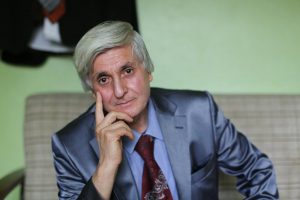Critique: The Effectiveness of a Social Media Campaign
Social media has given rise to a new form of advocacy and awareness for many social justice issues. The power of globalization through social media has created a community of social change and has called for action on many atrocities populations are facing in near and far lands. One incredibly popular social media photo-documentary series, Humans of New York, has an incredibly widespread audience from across the world and has spurred a popular form of connectivity between people. In 2014 and 2015, Brandon Stanton, the creator of Humans of New York created two series which are pertinent to populations we have discussed in class. These two series are named “Refugee Stories” and “Syrian Americans”.
Brandon Stanton created Humans of New York in 2010 as a photography project. Stanton’s initial goal was to photograph 10,000 New Yorkers. As it evolved Stanton began interviewing his subjects as well as photographing them which allowed for him to include quotes and short stories from the subjects. Humans of New York is now one of the most popular social media blogs with over 20 million followers on social media. Stanton has also expanded the stories he has received over the years to create two bestselling books and include stories from over twenty different countries. Stanton’s original goal was to provide a worldwide audience with daily glimpses into the lives of strangers. His series often focused on a particular population of people and aided in evoking a sense of sentiment within the stories and oftentimes included links to donate to causes or petitions to call for action.
The two series I am specifically focusing on are of significant relevance to the course as they tell the stories of refugees traveling across Europe as well as Syrian refugees selected for American resettlement. The series titled “Refugee Stories” revolved around the stories of Syrian refugees across Greece, Hungry, Croatia, and Austria. With the aid of the UNHCR, Stanton was able to travel to these countries in 2015 and interview migrant and refugees traveling across Europe. This series was incredibly popular as it was one of the first large scale social media campaigns which sought to bring awareness to the global refugee crisis. This series in particular worked to bring forth the stories of many Syrian refugees and highlight the violence and strife they experienced in their home country. Stanton has been praised for “humanizing” refugees and migrants and allowing for a global audience to connect with a group of people often seeking many of the same things as those in other countries such as peace, safety and a better future for their families. The series was incredible popular and aided in creating awareness as well as actions as in the pouring of donations to aid the refugees in obtaining basic necessities of life. Due to his partnership with the UNHCR, this series advocated for donations to be directed to the UNHCR. During this campaign Stanton was instrumental in ensuring that the UNHCR continued to receive donations.
The series titled “Syrian Americans” focused on the stories of 11 families which were approved for resettlement in the United States. This series surpassed the “Refugee Stories” and gained widespread support, including that of former President Barack Obama. The stories in this series were more detailed then those in “Refugee Stories” and included more explicit violence and loss which aided in making it a more popular campaign. The fact that these families had been placed for resettlement in the United States also aided in creating a sense of camaraderie with Americans which called for more action. The stories all highlighted loss, vulnerability and the difficulty they faced in relocating to a new country.The time of the year in which the stories were released also added to the contributions pouring in as the series debuted around Christmas time in 2015. In only three days, Stanton was able to raise over 700,000 dollars for the families in the series. This was over 7 times the original goal of the fundraiser.

Two particular stories received a great deal of attention by the audience of Humans of New York. Those two stories are that of “The Scientist” and “Aya”. “The Scientist” as he is referred to by the followers of the blog has a particularly gut-wrenching story which highlighted violence, death, despair and hope. His story highlighted an almost idyllic childhood and early adulthood plagued with anguish once Syria was invaded. His suffering did not only end with the violence that killed his wife, his daughter, and fourteen other family members in one day as when interviewed he is suffering from cancer. The response to the story was so great at the time that then President Barack Obama commented under one of the posts in his story. Actor and filmmaker Edward Norton helped raise over 400,000 dollars for “The Scientist” and his remaining family. The other story which resulted in a large campaign for change was that of Aya and her family. After years of suffering her petition for resettlement was denied. In response to this Stanton created a petition, which he phrased as an invitation, for President Barack Obama to state that Aya is not a threat and that she deserves a place in America. The petition became incredibly popular and amassed over one million signatures. Unfortunately, Aya did not receive placement in the United States and nearly two years later, Stanton provided an update stating that Aya had finally been resettled in Switzerland.
 While the series has gained a large amount of positive feedback, some people do critique Humans of New York for being “click bait” rather than “real journalism”. One particular critique which I feel relates to previous discussions we’ve had in class, states the sentiment that photo’s offer works to funnel social issues emotion into a mute form, preventing a union between thought and social action. This is stating that it calls for passive reading rather than true activism. The author of the critique states that the sentiment it produces works to sustain white Americans “blissful and deadly ignorance”. To view some of the portraits displayed on HONY while ignoring the fact that in a few years’ time the same people can be viewed as criminals and/or as a danger to society undermines the racial tensions in America and across the world. The stories portrayed on Humans of New York portray a safe alternative to racial tensions without ever truly addressing the issue. Another critique the author makes is the view of diversity through a single individual. The focus on Syrian refugees, mostly in families, excludes a large portion of migrants and refugees which are not covered by these narratives. By selecting certain stories Stanton creates a definition of ‘human’ which is constrained to a liberal, Western viewpoint. By people viewing the differences in the characters as ‘day to day circumstances’ ignores the structural and social barriers which work against groups of people. The statements made on some of the posts in the refugee camps in Europe state that it ‘humanized’ in the Middle East as opposed to news outlets for the past 40 years. The idea that HONY can humanize people indicates that before they were viewed as less than human and thus places a greater significance on the portraits that Humans of New York presents.
While the series has gained a large amount of positive feedback, some people do critique Humans of New York for being “click bait” rather than “real journalism”. One particular critique which I feel relates to previous discussions we’ve had in class, states the sentiment that photo’s offer works to funnel social issues emotion into a mute form, preventing a union between thought and social action. This is stating that it calls for passive reading rather than true activism. The author of the critique states that the sentiment it produces works to sustain white Americans “blissful and deadly ignorance”. To view some of the portraits displayed on HONY while ignoring the fact that in a few years’ time the same people can be viewed as criminals and/or as a danger to society undermines the racial tensions in America and across the world. The stories portrayed on Humans of New York portray a safe alternative to racial tensions without ever truly addressing the issue. Another critique the author makes is the view of diversity through a single individual. The focus on Syrian refugees, mostly in families, excludes a large portion of migrants and refugees which are not covered by these narratives. By selecting certain stories Stanton creates a definition of ‘human’ which is constrained to a liberal, Western viewpoint. By people viewing the differences in the characters as ‘day to day circumstances’ ignores the structural and social barriers which work against groups of people. The statements made on some of the posts in the refugee camps in Europe state that it ‘humanized’ in the Middle East as opposed to news outlets for the past 40 years. The idea that HONY can humanize people indicates that before they were viewed as less than human and thus places a greater significance on the portraits that Humans of New York presents.
Overall Stanton was successful in accomplishing his goal of reaching everyday people who would have otherwise remained in the dark to the difficulties that migrants and refugees face. His platform allowed for millions of people to understand the background of migrants and refugees and portray that it is not a voluntary choice. Many people, particularly in the United States did not understand why Syrians were fleeing and the narratives provided a way for everyday people to truly understand. Stanton’s second goal which was to become a catalyst for action was also successful as he was able to raise over one million dollars for refugees in order to aid in providing the basic necessities of life and medical care. Brandon Stanton was able to use his platform both as an awareness campaign and an instrument of positive social action.
Recent Comments